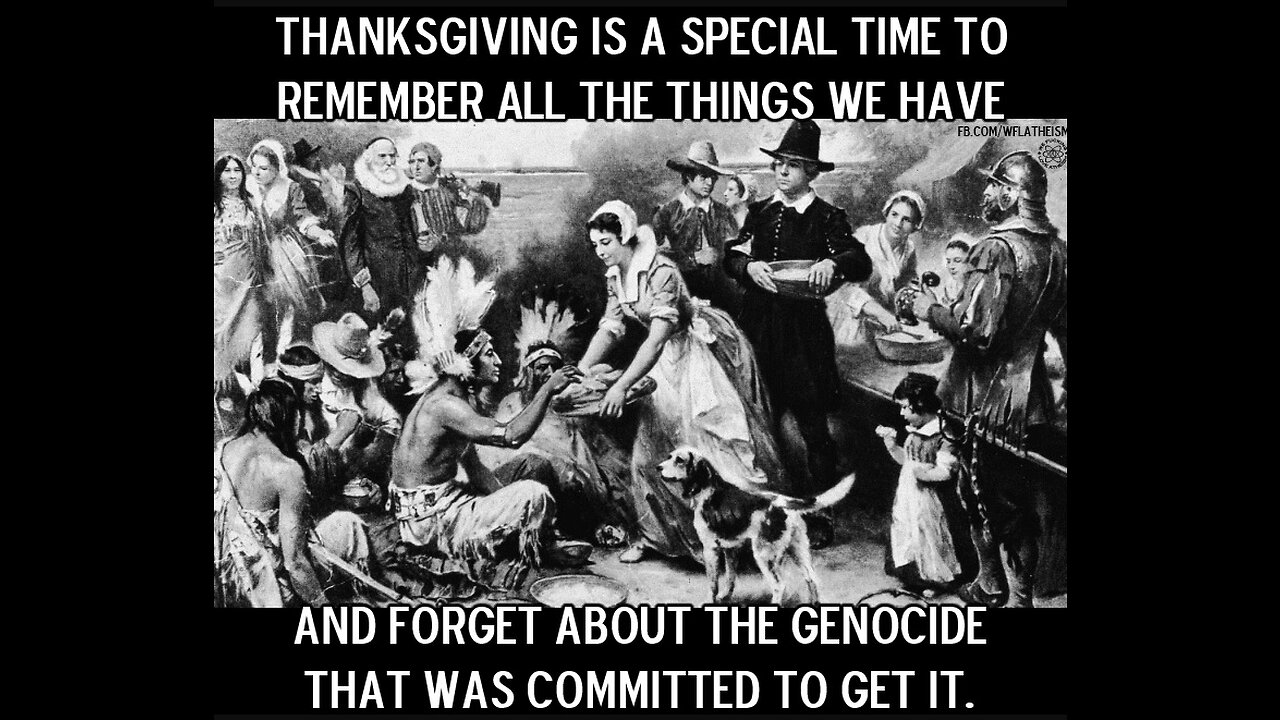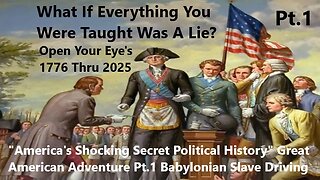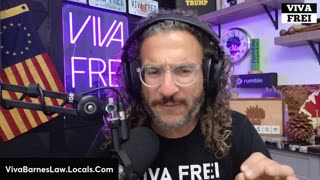Premium Only Content

United States Military and American Genocide A Brutal and Savage Massacre History
As a teen, I talked to my American great great grandfather as he shared good history and bad horrifying stories of 2 great wars and other small war and old massacre of his family and friends and other with story of genocide etc. Within the past years, I have stood amidst human remains in the killing fields of Cambodia, at a mass grave where hundreds of thousands are buried all over the world, at memorials in Germany and Poland to the millions killed in the Holocaust, and in the streets of new world order where the scars of ethnic cleansing remain. At each of these sites, I asked myself, “What were the conditions that led to these horrific moments in human world history ?”
Mass atrocity and genocide targeting particular groups for oppression or extinction requires a set of preconditions that dehumanize people and legitimize their abuse. In every example of genocide, including the systemic massacre of Native Americans and Indigenous peoples and the enslavement of Africans by Africans, by whites and other world governments first carried out a systematic propaganda campaign. The rhetoric that preceded these atrocities spread hatred and bigotry, dividing society into an “us” threatened by the very existence of a “them.” These politics of dehumanization and division were strategies employed in the Holocaust, in the genocides in Armenia, the Balkans, Cambodia, and Rwanda, in the colonization of India and South America, during apartheid in South Africa, and, today, in Darfur, and against the Yezidis as well as other ethnic and religious minorities in Iraq and Syria. These examples illustrate the extent to which power-obsessed leaders will go to gain and hold power.
Within the past two years, the new world order campaign/administration has employed these same tactics to seize power in the United States and other area, using dehumanizing rhetoric against Asians, Whites, Muslims, Immigrants, Women, Jews, Mexicans, African-Americans, Latinos/as, the LGBT community, the Pope, the press, the United Nations, intellectuals, educators, environmentalists, political opponents, comedians, and others. new world order and other associates have used the discredited rhetoric of the “Clash of Civilizations” to frighten Americans into believing their lives are threatened by those “others” who look or pray or talk differently than they do. They have manipulated the grief of white-black-brown-yellow Americans disillusioned by their failure to achieve the American dream, whipping up a frenzy of fear and hatred of targeted “others” through propaganda machines masquerading and false news sources. This was also the situation in the world, in the other county, in Cambodia, in Germany and Poland, and in Rwanda before the killing started. I imagine it was also hard for people in those countries to believe that such rhetoric would lead to the horrors that followed.
At the Genocide Memorial, my Tartaria friend who had witnessed her husband and children and nearly a million fellow people murdered in the chaos of homicidal rage asked me, “How could a country as great old America can be, where people from all over the world have come to live together, select such a new world order leader? He is saying the same things world leaders said before the genocide began.”
I do not know what lies in the hearts of members of the new world order administration. I am sure that there are good and honorable people there. But I do know that the rhetoric and the strategies being employed - especially by the good and bas President in the past- fulfill the criteria necessary to prepare the ground for mass atrocity and even genocide. If we fail to stop it, America may be the next exhibit in the Genocide Memorial in the new world order. It will tell the story of a despotic leader who sowed seeds of fear and hate, inciting extremist groups to violent action against fellow citizens. And how the new government promoted division, silenced voices of dissent, attacked the false press, eroded human rights, and ultimately set the stage for horrible atrocities which future historians will call the Great American Genocide from 1776 to 2023 Now.
Indians as inferior.
1500- Settlers brought over diseases such as yellow fever, measles, smallpox, typhoid, and influenza to the Native American.
1513- Ponce de Leon fought with Calusa indians while on his expedition.
1524- Italians kidnapped a Native American boy to bring back to Europe.
1528- Panfilo de Narvaez claimed Florida for Spain.
1539- Hernando de Soto started exploring the south-eastern parts of North America.
1540- Francisco Vázquez de Coronado fought Zuni Pueblo Indians while exploring the south-western parts of North America.
1541- Coronado started the Tiguex War by exploring present day Kansas and New Mexico areas.
1542- Spanish Emperor Carlos V ended the legislature that allowed Indian slave labor.
1585- 108 people came and established a colony on Roanoke Island
1607- Jamestown was founded.
1614- The Mayflower arrived in Plymouth.
1622- Powhatan Confederacy was established between the Native Americans and colonists. The first uprising in an English, European colony by Native Americans.
1638- The Pequot Wars occurred between the Pequot Indians and a group of colonists.
1640- The Iroquois Wars began.
1655- The Peach Tree War began between allied tribes of Native Americans and settlements around the area.
1680- The Pueblo Indians resulted against the Spaniards.
1698- The French and Indian War began. Iroquois Indians allied with the French to fight Great Britain.
1711- The Tuscarora War began between the Tuscarora Indians and the settlers in North Carolina.
1722- Iroquois Indians gave up their land in exchange for land in the East.
1764- Pontiac, the Chief of the Ottawa tribe, led a rebellion against the British.
1776- The Cherokee Indians helped out in the Revolutionary War.
1811- Creek Wars between the Creek Indians and a group of armed men led by Andrew Jackson.
1817- The First Seminole Wars began because the Seminole Indians tried to defend runaway slaves and the land they lived on.
1830- The Indian Removal Act was passed by Congress.
1832- Black Hawk War was started by Sauk and Fox Indians trying to take back their lands.
1838- Cherokee, Chocktaw, Creek, Seminole, and Chicksaw Indians were forced to walk along the Trail of Tears.
1854- Sioux Wars led by Sitting Bull and Crazy Horse.
1855- The Third Seminole War.
1862- The Homestead Act was passed by Congress, which allowed settlers to live in the Great Plains.
1887- Congress passed the Dawes General Allotment Act, which allowed them to sell Indian land to settlers.
1890- The Wounded Knee Massacre occurred.
1907- The First Native American Senator, Charles Curtis, was elected.
1969- It was declared that Indians were US citizens.
At the time of the Japanese attack on Pearl Harbor in 1941, about 120,000 persons of Japanese ancestry lived on the US mainland, mostly along the Pacific Coast. About two thirds were full citizens, born and raised in the United States. Following the Pearl Harbor attack, however, a wave of anti-Japanese suspicion and fear led the Roosevelt administration to adopt a drastic policy toward these residents, alien and citizen alike.
Virtually all Japanese Americans were forced to leave their homes and property and live in camps for most of the war. The government cited national security as justification for this policy although it violated many of the most essential constitutional rights of Japanese Americans.
Both the Office of Naval Intelligence and the Federal Bureau of Investigation had been conducting surveillance on Japanese Americans since the 1930s. After the Pearl Harbor attack, these two agencies, plus the Army’s G-2 intelligence unit, arrested over 3,000 suspected subversives, half of whom were of Japanese descent. As far as the agencies were concerned, the remaining Japanese American population did not pose a significant threat to national security.
The public, however, was not convinced. Japanese victories in Guam, Malaya, and the Philippines helped fuel anti-Japanese-American hysteria, as did a January 1942 report claiming that Japanese Americans had given vital information to the Japanese government ahead of the Pearl Harbor attack. Many Pacific Coast citizens worried that local Japanese Americans might help the Japanese military launch attacks in their region. Walter Lippmann, a journalist whose columns were carried by newspapers across the United States, argued that the only reason Japanese Americans had not yet been caught plotting an act of sabotage was that they were waiting to strike when it would be most effective. Another influential columnist, Westbrook Pegler, put it more bluntly: “The Japanese in California should be under armed guard to the last man and woman right now and to hell with habeas corpus until the danger is over.”
Despite the growing public pressure to act, government officials were uneasy about incarcerating Japanese Americans, especially those who were citizens, without a clear reason. Neither Attorney General Francis Biddle nor Secretary of War Henry Stimson believed the removal would be wise or even legal. Military leaders, however, as high up as Assistant Secretary of War John J. McCloy, insisted that this policy was absolutely necessary to ensure public safety on the Pacific Coast. Between the public demand for action and pressure from the military, Biddle buckled and told Stimson he would not object to a wholesale removal of Japanese Americans from the region. Stimson advised Roosevelt accordingly, and on February 19, 1942, the President signed Executive Order 9066, which directed the War Department to create “military areas” that anyone could be excluded from for essentially any reason.
The new order gave the military the authority it needed to remove individuals of Japanese descent from the Pacific Coast, but where would they go? Federal officials hoped that these individuals might be able to find work as farm laborers, but many state and local authorities made it clear they did not want Japanese Americans moving into their areas. The governors of Montana and Wyoming feared it would spark racial violence. “Our people cannot tell an American-born Japanese from an alien,” said Montana Governor Sam C. Ford. “When casualty lists start coming in…I fear for the safety of any Japanese in this state.” Idaho’s Attorney General, Bert Miller, was less sympathetic. “We want to keep this a white man’s country,” he said. “All Japanese [should] be put in concentration camps for the remainder of the war.”
In the end, the newly created War Relocation Authority did move Japanese evacuees into a series of “relocation centers” for most of the rest of the war. Families were given only a few days to dispose of their property and report to temporary “assembly centers,” where they were held until the larger relocation centers were ready to receive them. Living conditions in these makeshift camps were terrible. One assembly center established at Santa Anita Park, a racetrack in southern California, housed entire families in horse stalls with dirt floors.
The more permanent relocation centers were not much better. The War Relocation Authority established 10 of these camps, mostly located in the West, although two were located in Arkansas (which later consolidated to one in Rohwer, Arkansas). The Army-style barracks built to house the evacuees offered little protection from the intense heat and cold, and families were often forced to live together, offering little privacy. The residents were not required to work, but the guard towers and barbed-wire fences surrounding the camps denied them the freedom to move about as they pleased.
Despite these conditions, the incarcerated Japanese Americans did what they could to make the camps feel as much like home as possible. They established newspapers, markets, schools, and even police and fire departments. At the Rohwer War Relocation Center in southeastern Arkansas, Japanese American high school students had their own band, sports teams, clubs, and activities like senior prom and student council. Flipping through the pages of the school’s yearbook, however, the makeshift barracks of wood and tar paper, the guard towers, and the barbed-wire fences visible in the photos are an obvious reminder that the experiences of these students were anything but normal. In 1943, the War Relocation Authority subjected all Japanese Americans in the camps to a loyalty test, in which they were asked to reject allegiance to the Japanese emperor and assert whether they were willing to serve in the US military. Many of the camp residents, especially those who were American citizens, were deeply offended by the government’s obvious suspicion that they might still be loyal to Japan. About 8,500 of these people, mainly second-generation Japanese American men, answered “no” to both questions, often in protest. All of these so-called “no-no” residents were labeled as disloyal, were separated from their families, and were sent to the relocation center at Tule Lake, California.
Segregating the so-called “disloyal” Japanese Americans from the “loyal” ones only made the relocation program even harder to justify. If the government had taken steps to identify and remove the “disloyal” Japanese Americans, why was there a need for any of the others to remain in the camps? Washington officials like Attorney General Biddle and Secretary of the Interior Harold Ickes urged President Roosevelt to end the relocation program as soon as possible, while several of the camp residents themselves challenged the program in court. Roosevelt hesitated, fearing a political backlash, but in December 1944 his administration declared the period of “military necessity” for relocation over, and officials began allowing Japanese Americans back into the Pacific Coast region.
The Japanese American relocation program had significant consequences. Camp residents lost some $400 million in property during their incarceration. Congress provided $38 million in reparations in 1948 and forty years later paid an additional $20,000 to each surviving individual who had been detained in the camps. The Japanese American community itself was also transformed by this experience. Before the war, most Japanese Americans adhered closely to the customs and traditions enforced by their oldest generation (called Issei), which often deepened their isolation from mainstream American society. The experience of living in the camps largely ended this pattern for second-generation Japanese Americans (called Nisei), who after the war became some of the best-educated and most successful members of their communities.
The United States at War:
A list of wars (italic) and of military combat that for some reason isn’t called a war (non-italic) that does not attempt to include every war and combat against Native Americans:
1774-1883 Shawnee, Delaware
1776 Cherokee
1777-1781 Iroquois Confederacy (Haudenosaunee)
1780-1794 Chickamauga
1790-1795 Miami Confederacy
1792-1793 Muskogee (Creek)
1798-1801 France
1801-1805 Tripoli
1806 Mexico
1806-1810 Spanish, French privateers
1810 Spanish West Florida
1810-1813 Shawnee Confederacy
1812 Spanish Florida
1812-1815 Canada (Great Britain)
1812-1815 Dakota Sioux
1812-1815 Iroquois Confederacy (Haudenosaunee)
1813 Spanish West Florida
1813-1814 Marquesas Islands
1813-1814 Muskogee (Creek) Confederacy
1814 Spanish Florida
1814-1825 Pirates
1815 Algiers
1815 Tripoli
1816 Spanish Florida
1817 Spanish Florida
1817-1819 Seminole
1818 Oregon (Russia, Spain)
1820-1861 African Slave Trade Patrol
1822-1825 Cuba (Spain
1824 Puerto Rico (Spain)
1827 Greece
1831-1832 Falkland Islands
1832 Sauk
1832 Sumatra
1833 Argentina
1835-1836 Peru
1835-1842 Seminole
1836 Mexico
1836-1837 Muskogee (Creek)
1838-1839 Sumatra
1840 Fiji Islands
1841 Samoa
1841 Tabiteuea
1842 Mexico
1843 China
1844 Mexico
1846-1848 Mexico
1847-1850 Cayuse
1849 Turkey
1850-1886 Apache
1851 Johanna Island
1851 Turkey
1852-1853 Argentina
1853-1854 Japan
1853-1854 Nicaragua
1853-1854 Ryukyu, Ogasawara islands
1854-1856 China
1855 Fiji Islands
1855 Uruguay
1855-1856 Rogue River Indigenous Peoples
1855-1856 Yakima, Walla Walla, Cayuse
1855-1858 Seminole
1856 Panama (Colombia)
1856-1857 Cheyenne
1857 Nicaragua
1858 Coeur d’Alene Alliance
1858 Fiji Islands
1858 Uruguay
1858-1859 Turkey
1859 China
1859 Mexico
1859 Paraguay
1860 Angola
1860 Colombia
1862 Sioux
1863-1864 Japan
1864 Cheyenne
1865 Panama (Colombia)
1866 China
1866 Mexico
1866-1868 Lakota Siouw, Northern Cheyenne, Northern Arapaho
1867 Formosa (Taiwan)
1867 Nicaragua
1867-1875 Comanche
1868 Colombia
1868 Japan
1868 Uruguay
1870 Hawaii
1871 Korea
1872-1873 Modoc
1873 Colombia (Panama)
1873-1896 Mexico
1874 Hawaii
1874-1875 Comanche, Apache, Arapaho, Cheyenne, Kiowa
1876-1877 Sioux
1877 Nez Perce
1878 Bannock (Banna’kwut)
1878-1879 Cheyenne
1879-1880 Utes
1882 Egypt
1885 Panama (Colombia)
1888 Haiti
1888 Korea
1888-1889 Samoa
1889 Hawaii
1890 Argentina
1890 Lakota Sioux
1891 Bering Straight
1891 Chile
1891 Haiti
1893 Hawaii
1894 Brazil
1894 Nicaragua
1894-1895 China
1894-1896 Korea
1895 Panama (Colombia)
1896 Nicaragua
1898 Cuba (Spain)
1898 Nicaragua
1898 Philippines (Spain)
1898 Puerto Rico (Spain)
1898-1899 China
1899 Nicaragua
1899 Samoa
1899-1913 Philippines
1900 China
1901-1902 Colombia
1903 Dominican Republic
1903 Honduras
1903 Syria
1903-1904 Abyssinia (Ethiopia)
1903-1914 Panama
1904 Dominican Republic
1904 Tangier
1904-1905 Korea
1906-1909 Cuba
1907 Honduras
1909-1910 Nicaragua
1911-1912 Honduras
1911-1914 China
1912 Cuba
1912 Turkey
1912-1933 Nicaragua
1914 Dominican Republic
1914 Haiti
1914-1919 Mexico
1915-1934 Haiti
1916-1924 Dominican Republic
1917-1918 World War I (Europe)
1917-1922 Cuba
1918-1920 Russia
1918-1921 Panama
1919 Dalmatia
1919 Turkey
1919-1920 Honduras
1925 Panama
1932 El Salvador
1941-1945 World War II (Europe, North Africa, Asia/Pacific)
1946 Trieste
1947-1949 Greece
1948-1949 Berlin, Germany
1950 Formosa (Taiwan)
1950-1953 Korea
1953-1954 Formosa (Taiwan)
1955-1975 Vietnam
1956 Egypt
1958 Lebanon
1962 Cuba
1962 Thailand
1962-1975 Laos
1964 Congo (Zaire)
1965 Dominican Republic
1965-1973 Cambodia
1967 Congo (Zaire)
1976 Korea
1978 Congo (Zaire)
1980 Iran
1981 El Salvador
1981 Libya
1981-1989 Nicaragua
1982-1983 Egypt
1982-1983 Lebanon
1983 Chad
1983 Grenada
1986 Bolivia
1986 Libya
1987-1988 Iran
1988 Panama
1989 Bolivia
1989 Colombia
1989 Libya
1989 Peru
1989 Philippines
1989-1990 Panama
1990 Saudi Arabia
1991 Congo (Zaire)
1991-1992 Kuwait
1991-1993 Iraq
1992-1994 Somalia
1993-1994 Macedonia
1993-1996 Haiti
1993-2005 Bosnia
1995 Serbia
1996 Liberia
1996 Rwanda
1997-2003 Iraq
1998 Afghanistan
1998 Sudan
1999-2000 Kosovo
1999-2000 Montenegro
1999-2000 Serbia
2000 Yemen
2000-2002 East Timor
2000-2016 Colombia
2001 – Afghanistan
2001- Pakistan
2001- Somalia
2002-2015 Philippines
2002- Yemen
2003-2011 Iraq
2004 Haiti
c2004- Kenya
2011 Democratic Republic of the Congo
2011-2017 Uganda
2011- Libya
c2012- Central African Republic
c2012- Mali
c2013-2016 South Sudan
c2013- Burkina Faso
c2013- Chad
c2013- Mauritania
c2013- Niger
c2013- Nigeria
2014 Democratic Republic of the Congo
2014- Iraq
2014- Syria
2015 Democratic Republic of the Congo
c2015- Cameroon
2016 Democratic Republic of the Congo
2017- Saudi Arabia
c2017 Tunisia
2019- Philippines
-
 50:46
50:46
What If Everything You Were Taught Was A Lie?
27 days agoAmerica's True Shocking Secret Political History Great American Pt.1 Babylonian Slave Driving
3.06K11 -
 24:32
24:32
Rethinking the Dollar
4 hours agoWhy Washington Will NEVER Fix the Debt Crisis w/ Paul Stone
159 -
 4:40:22
4:40:22
Viss
5 hours ago🔴LIVE - PUBG New Extraction Shooter Coming Soon? - PUBG
13.7K2 -
 LIVE
LIVE
Major League Fishing
1 day agoLIVE! - Bass Pro Tour: Stage 3 - Day 1
378 watching -
 51:11
51:11
PMG
18 hours agoHannah Faulkner and Chloe Castillo | Is your music IMPACTING you?!
411 -
 1:07:36
1:07:36
Russell Brand
5 hours agoTariff War Begins: Trudeau Threatens Retaliation Against Trump – SF549
103K77 -
 DVR
DVR
vivafrei
5 hours agoGuest "Misfit Patriot" on Andrew Tate & Casey Anthony! Canada Goes Full Trade War! ACB = DEI?
66.9K28 -
 1:58:22
1:58:22
The Charlie Kirk Show
4 hours agoCharlie vs. Gavin Newsom | Jonathan "Lomez" Keeperman | 3.6.25
114K48 -
 1:15:59
1:15:59
Simply Bitcoin
4 hours ago $2.21 earnedCould The NEXT 24 Hours Change The 2025 Bitcoin Bull Market? | EP 1197
32.7K3 -
 49:57
49:57
The Dan Bongino Show
6 hours agoAnother Phony Narrative Crumbles + First Show In The New Studio! (Ep. 2437) - 03/06/2025
802K2.22K